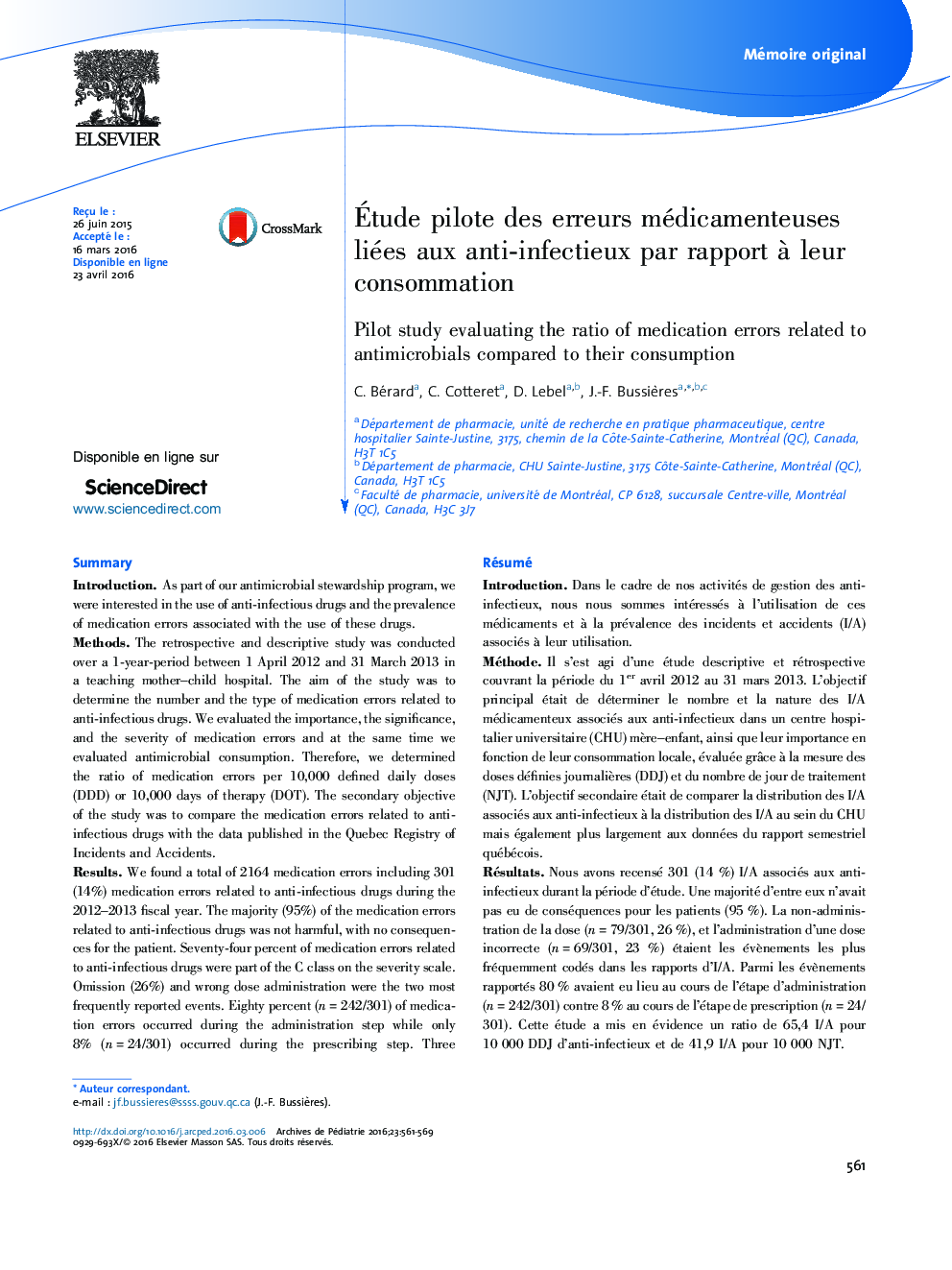| Article ID | Journal | Published Year | Pages | File Type |
|---|---|---|---|---|
| 4145625 | Archives de Pédiatrie | 2016 | 9 Pages |
RésuméIntroductionDans le cadre de nos activités de gestion des anti-infectieux, nous nous sommes intéressés à l’utilisation de ces médicaments et à la prévalence des incidents et accidents (I/A) associés à leur utilisation.MéthodeIl s’est agi d’une étude descriptive et rétrospective couvrant la période du 1er avril 2012 au 31 mars 2013. L’objectif principal était de déterminer le nombre et la nature des I/A médicamenteux associés aux anti-infectieux dans un centre hospitalier universitaire (CHU) mère–enfant, ainsi que leur importance en fonction de leur consommation locale, évaluée grâce à la mesure des doses définies journalières (DDJ) et du nombre de jour de traitement (NJT). L’objectif secondaire était de comparer la distribution des I/A associés aux anti-infectieux à la distribution des I/A au sein du CHU mais également plus largement aux données du rapport semestriel québécois.RésultatsNous avons recensé 301 (14 %) I/A associés aux anti-infectieux durant la période d’étude. Une majorité d’entre eux n’avait pas eu de conséquences pour les patients (95 %). La non-administration de la dose (n = 79/301, 26 %), et l’administration d’une dose incorrecte (n = 69/301, 23 %) étaient les évènements les plus fréquemment codés dans les rapports d’I/A. Parmi les évènements rapportés 80 % avaient eu lieu au cours de l’étape d’administration (n = 242/301) contre 8 % au cours de l’étape de prescription (n = 24/301). Cette étude a mis en évidence un ratio de 65,4 I/A pour 10 000 DDJ d’anti-infectieux et de 41,9 I/A pour 10 000 NJT.ConclusionL’utilisation de ce type de ratio permettrait de réviser les priorités d’action en matière de prévention et de gestion des risques associés aux anti-infectieux en établissement de santé.
SummaryIntroductionAs part of our antimicrobial stewardship program, we were interested in the use of anti-infectious drugs and the prevalence of medication errors associated with the use of these drugs.MethodsThe retrospective and descriptive study was conducted over a 1-year-period between 1 April 2012 and 31 March 2013 in a teaching mother–child hospital. The aim of the study was to determine the number and the type of medication errors related to anti-infectious drugs. We evaluated the importance, the significance, and the severity of medication errors and at the same time we evaluated antimicrobial consumption. Therefore, we determined the ratio of medication errors per 10,000 defined daily doses (DDD) or 10,000 days of therapy (DOT). The secondary objective of the study was to compare the medication errors related to anti-infectious drugs with the data published in the Quebec Registry of Incidents and Accidents.ResultsWe found a total of 2164 medication errors including 301 (14%) medication errors related to anti-infectious drugs during the 2012–2013 fiscal year. The majority (95%) of the medication errors related to anti-infectious drugs was not harmful, with no consequences for the patient. Seventy-four percent of medication errors related to anti-infectious drugs were part of the C class on the severity scale. Omission (26%) and wrong dose administration were the two most frequently reported events. Eighty percent (n = 242/301) of medication errors occurred during the administration step while only 8% (n = 24/301) occurred during the prescribing step. Three anti-infectious drugs had the highest ratio of medication errors per 10,000 DDD or DOT: linezolid (376 medication errors per 10,000 DDD), doxycycline (357 medication errors per 10,000 DDD), and acyclovir (202 medication errors per 10,000 DDD). The nonparametric tests showed no significant differences between frequently used and infrequently used anti-infectious drugs for the ratio of medication errors per 10,000 DOT. This pilot study showed a ratio of 65.4 medication errors/10,000 DDD of anti-infectious drugs and a ratio of 41.9 medication errors/10,000 DOT of anti-infectious drugs.ConclusionThe use of these ratios could contribute to focusing on monitoring anti-infectious drugs and improving the risk management system associated with this class of drugs. It also shows that less frequently used anti-infectious drugs should be managed with greater caution. Anti-infectious stewardship programs should also consider ratios of medication errors for anti-infectious drugs used in order to improve patient safety and optimize use of drugs.
